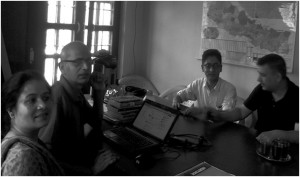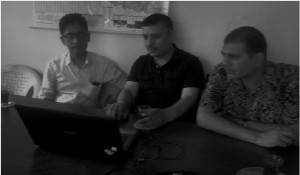MF staff at work on disaster reporting resources for the media in the wake of April/May earthquake.

Did you say ‘just a click?”

“Alarming reports, much work to do.”

MF staff at work on disaster reporting resources for the media in the wake of April/May earthquake.

Did you say ‘just a click?”

“Alarming reports, much work to do.”
The latest edition of Hope magazine features a write-up by Bharat Dutta Koirala, chair of Media Foundation. In the article, Koirala traces the evolution of development journalism and reflects on the future.
By Bharat Dutta Koirala
In the late 1970s, I had the opportunity to spend a week in King Birendra’s camp in Surkhet. It was customary to invite journalists to share King’s experience at the end of his month-and-a half long visit to a development region. During the week, I also visited various communities in the vicinity of the camp and wrote about the activities of the people, describing their work-a-day life, their hopes and aspirations, the impact of the royal visit on their lives and the attitudinal changes that their growing interactions with the rest of the country had brought about. I wrote a series of articles on what I experienced during that week. These articles, published simultaneously in the Gorkhapatra and the Rising Nepal were intended not only to highlight the changing face of Surkhet but also to inspire further development of the Valley and the rest of the country. In my one-to-one interview with the King on the final day of his stay in the camp, we discussed the impact of the King’s visit and the concept of development journalism. The King liked all of the articles and wanted to do something about making his administration more communication-oriented and the National News Agency to cover more development news than just report details of the royal movements or the speeches of his ministers.
Media Foundation has just completed a major study on Nepali media, Media and the Nepali Public: Survey Assessments of Media Capacity, Media Credibility and Media Literacy. The following is the executive summary of the study, with findings and recommendations:
MEDIA & THE NEPALI PUBLIC: Survey Assessments of Media Capacity, Media Credibility and Media Literacy (Media Foundation- Nepal, Kathmandu)
EXECUTIVE SUMMARY
Introduction
This report attempts to provide a summary of Nepali journalists’ views on the professional challenges they face, their capacity development needs, their perceptions of media credibility, and their suggestions to improve the overall quality of journalism in the country. It also seeks to offer a snapshot of public views on media and their credibility, level of reliability of media as the source of information on contemporary issues, as well as the level of media literacy of the citizens.
Op-ed article by Dharma Adhikari of Media Foundation in Republica daily newspaper. In the article, Adhikari emphasizes on the need for a systematic, continued and independent media monitoring and analysis.
By Dharma Adhikari
First some crude estimates based on available data:
On average, with 1,800 words a page, the daily weekday edition of Republica offers its readers close to 30,000 words. The combined 164 pages of the country’s 11 broadsheets produce around 350,000 words a day. Add to that the 78 smaller dailies (Press Council Nepal, 2010) in print today, mostly 4-page tabloids, 312 in cumulative pages. They produce nearly 300,000 words a day, with an average of 900 words a page.
At an average human reading speed of 250 words a minute, it will take about 48 hours non-stop for a person to read all our daily newspapers today. More words and reading time for the 425 or so weeklies and other periodicals.
At the average broadcast speaking speed of 135 words per minute, the 12 Nepal-focused TV channels alone produce over 2.3 million words a day, repeats included. Each channel transmits 25 unique image frames per second. By the same token, over 36 million words are aired daily by the 186 plus radio stations in action today.
On the virtual front, the active Websites among the 20,844 Nepal-specific domains (.np) registered to date by Mercantile Communications in Kathmandu and a few thousand Nepal-focused others from outside the country as well as many blogs and social networking platforms churn out many gigabytes of content.
And much more content is generated by the 7.99 million telephony devices, including 6.83 million mobiles in use in the country (Nepal Telecom Authority, April 2010).
All eyes in Nepal are on the Constitution-Making Process (CMP). With the May 28, 2010 deadline for the drafting of the constitution fast approaching, barely 6 months remain to reach the goal, requiring more intense focus on the process. This resource is part of an ongoing project of the Media Foundation to create an inventory on useful online information and tools on the CMP, for journalists, writers and researchers.
It includes global and national historical perspectives, a timeline for Nepal, links to Constitutional Committees and their activities, and useful online resources on CMP and the role of media. Above all, this tool kit is designed to help locate relevant information quickly and efficiently in a single platform.
Constitutional waves in history
As of November 20, 2009, the Constitution-finder (at University of Virginia at Richmond) records a total of 201 constitutions of nations and territories around the world. According to Dr Jochen Abr. Frowein, Director of the Max-Planck-Institute for Comparative Public Law and International Law, there have been at least 3 major waves of constitution making in history. The first began after World War I. The second started after the liberalization process, following World War II. The collapse of the communist empire and the end of Cold War in 1989coincided with another wave of constitution making, in what is also described as the “third wave” of democratization process.
A recent (March 4-7, 2008) Princeton University deliberation notes that the newest wave of constitution making has several distinct causes:
“The new wave of constitution making has several distinct causes. Institutional crisis and the shift to multi-party rule as an attempt to generate greater governmental accountability necessitated new constitutions in some instances. In others, people have lost confidence in democracy and now seek to re-work some of the institutional arrangements putt in place earlier [Somewhat relevant to Nepal]. Wars and peace settlements [Relevant to Nepal], or the collapse of federations, have also precipitated the creation of new constitutions. In some instances, constitutions and constitution making are frameworks for continued negotiations and must assume the difficult task of creating order.”
So far, 282 people have lost their lives in Nepal’s Far West Region’s Diarrhoeal epidemic that began in early May. The most affected is Jajarkot district (141 deaths). Rukum has also suffered 46 deaths. In all, 19 districts are affected.
Since access is limited to the region due to difficult geography and the monsoon season, latest figures are not available and those that are available are updates mainly from the international relief agencies. The government’s official Websites have posted little, if any, information on the crisis.
© Media Foudation- 2024 | Site by: SoftNEP